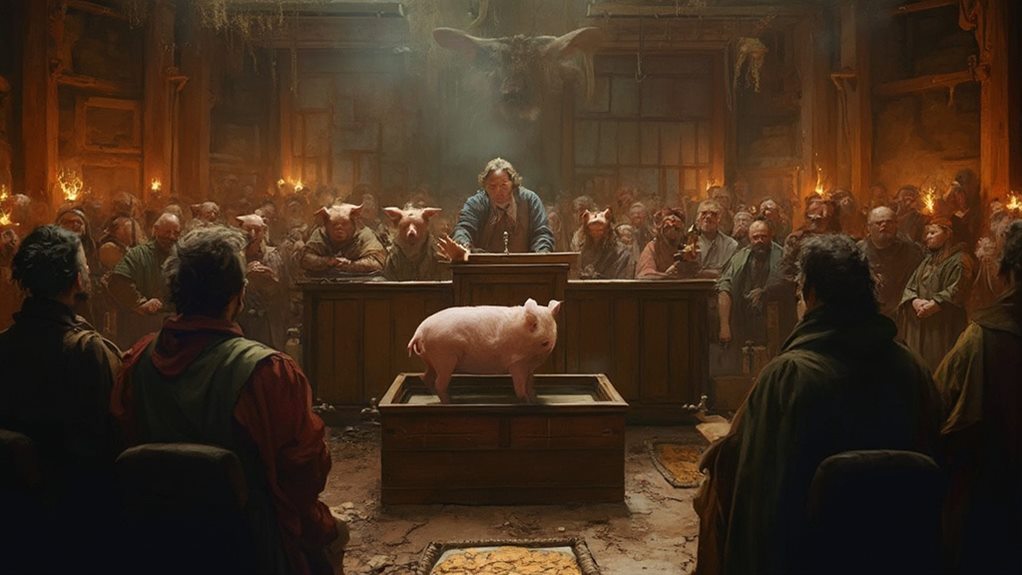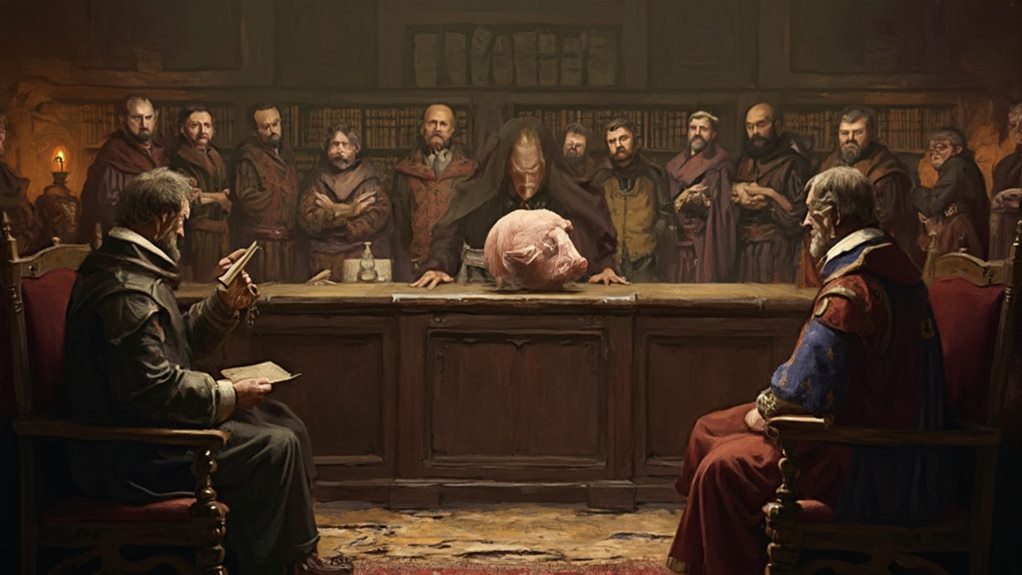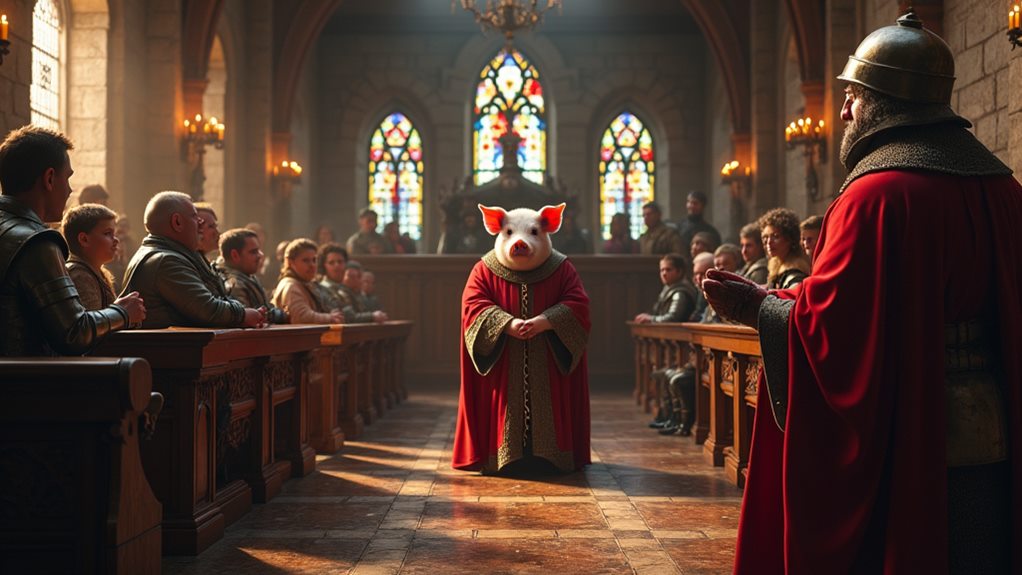A courtroom where the scales of justice weigh not just human deeds but the actions of pigs, goats, and beetles? You might find it peculiar, yet in medieval Europe, animals stood trial, facing accusations as serious as those against people. This practice reveals much about the era’s social frameworks and ethical considerations. Why put a sow on trial for infanticide or summon a swarm of insects to court?
These questions point to an intriguing intersection of law, culture, and superstition that shaped medieval society. Explore how these trials might still whisper lessons to our modern justice system.
Origins of Animal Trials

In medieval Europe, the peculiar practice of animal trials emerged as a reflection of societal and legal norms. Imagine living in a time when pigs, goats, and even insects could be dragged into courtrooms, facing charges as if they were little furry criminals.
This might sound like a scene from a fairy tale, but it’s rooted in the historical context of the Middle Ages. Back then, societal norms dictated that animals were part of the moral community, subjected to the same laws as humans. This legal evolution highlights how people grappled with notions of justice and animal rights long before modern times.
You might wonder why these trials happened at all. Well, medieval folks believed animals had a kind of moral agency, meaning they could distinguish right from wrong—at least in theory. This belief stemmed from moral philosophy, where the line between humans and animals was fuzzier than you’d expect.
While it might seem absurd today, these trials were a serious affair. They reflected the era’s attempts to impose order and justice, illustrating how societies evolve over time. So, next time your pet misbehaves, be thankful they won’t end up in court!
Notable Cases in History
While the concept of animal trials might seem bizarre, several notable cases highlight just how seriously medieval societies treated these proceedings. Imagine this: in 1386, a sow was put on trial in Falaise, France, for the gruesome act of infanticide.
This famous animal defendant, clad in human clothing, faced the court. The bizarre trial outcome? Convicted and executed in public, reflecting the intense societal reactions of the time. Historical documentation reveals that public opinion demanded justice, even for animals, underlining the belief that accountability extended beyond humans.
Another case involved a swarm of beetles in 16th-century France, accused of ravaging crops. The trial, documented with both humor and seriousness, resulted in a strange compromise—offering the beetles a designated field. Though the outcome seems absurd, it shows how medieval people engaged in a dialogue with nature, reflecting their societal values.
These cases, with their blend of justice and absurdity, offer a glimpse into a world where even animals faced the law. They weren’t mere spectacles; they mirrored the community’s moral compass, illustrating how deeply ingrained such practices were in shaping societal norms.
Legal Procedures and Rituals

Beyond the oddity of animal trials lies a structured process that medieval societies took quite seriously. Imagine a bustling courtroom where pigs, goats, and even beetles stood accused of various crimes. These trials followed specific courtroom rituals, reflecting the legal systems of the time.
You’d witness the solemnity of judges and the formality of proceedings as animals received legal representation, often by appointed attorneys who crafted defense strategies on their behalf. It might sound absurd today, but back then, they believed in giving every creature a fair shot at justice.
Witness testimonies played an essential role, with townsfolk recounting events to determine the accused animal’s fate. You can picture the earnestness with which people presented their stories, as if a pig on trial was as consequential as a human defendant.
Depending on the outcome, punishment methods varied widely, from execution for serious offenses to exile or even pardons for lesser crimes. It’s a curious blend of justice and ritual, isn’t it? This unique legal practice offers a fascinating glimpse into how medieval societies sought order, even when dealing with creatures that couldn’t speak for themselves.
Cultural Beliefs and Superstitions
A myriad of cultural beliefs and superstitions shaped the medieval approach to animal trials. You might wonder why pigs, goats, and even beetles found themselves in court. Well, animal symbolism played a huge role. Animals were often seen as embodiments of certain traits or omens.
For instance, a pig might symbolize gluttony or sin, making it an easy target when things went wrong in a village. Society’s folklore influences also fueled these trials. Tales of talking animals or creatures causing mischief were common and blurred the lines between reality and imagination.
Religious beliefs further anchored these practices. Many medieval folks believed that animals, like humans, could sin and as a result had to answer for their actions. This anthropomorphism effect, where animals were given human-like qualities and roles, made such trials seem logical at the time.
In their societal roles, animals weren’t just livestock but were seen as participants in the moral and spiritual landscape. The spectacle of a goat on trial, with all its “evil” deeds dissected by earnest townsfolk is a bizarre blend of justice and theater, shaped by the unique fabric of medieval cultural beliefs.
Impact on Society

The bizarre practice of putting animals on trial had a profound impact on medieval society. A courtroom where a pig stands accused of mischief sounds absurd, right? Yet, these trials had real social implications. They reflected the community values of the time, illustrating how society grappled with moral considerations and justice. In this historical context, these trials were more than just spectacles; they mirrored the public perception of fairness and order.
You might wonder how people reacted when a goat was led to court. Well, the public perception was a mix of entertainment and serious moral lessons. These trials served as a reminder of the community’s moral code, subtly reinforcing the idea that everyone, human or animal, was accountable for their actions. The social implications were significant, as they helped maintain community cohesion and established a sense of shared values.
Humor aside, these trials reveal much about medieval life. They highlight a time when people sought to make sense of their world by applying human laws to animals. It’s a fascinating glimpse into how societies have evolved, shaped by their unique moral and ethical frameworks.
Lessons for Modern Justice
Out of the medieval practice of animal trials, modern justice systems can glean some unexpected insights. You might chuckle at the thought of pigs and beetles standing trial, but these cases highlight how societal values have evolved.
Medieval courts were surprisingly ahead of their time in considering non-human entities within the legal framework, hinting at today’s debates over animal rights and legal personhood. Imagine a beetle being judged for crop damage—it’s absurd, yet it underscores an early recognition of animals as subjects of legal concern.
Fast forward to now, and you’ll see the justice evolution in full swing. Modern courts grapple with questions about animals’ status and rights, influenced by historical precedents that once seemed downright bizarre.
These trials remind us that societal values are not static; they change and adapt. By acknowledging animals in the legal process, medieval societies planted seeds for discussions about justice that we’re still having.
Wrapping up
Let’s say you’re a medieval juror, deciding the fate of a pig in a courtroom buzzing like a beehive with curious onlookers. These animal trials, while seemingly absurd today, were society’s way of grappling with justice and morality, threading animals into the fabric of their ethical mosaic.
While you reflect on this quirky chapter of history, consider how it nudges you to ponder modern justice, reminding you that every era has its own peculiar dance with fairness.




